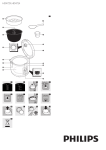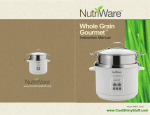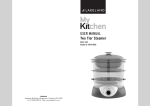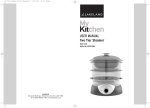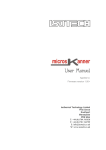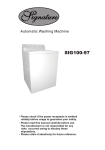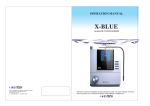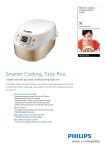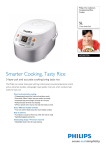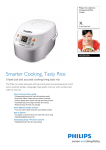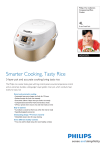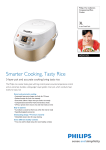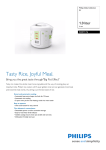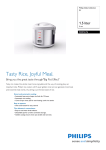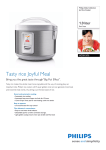Download EnGLISh
Transcript
English Introduction Congratulations on your purchase and welcome to Philips! To fully benefit from the support that Philips offers, register your product at www.philips. com/welcome. General description (Fig. 1) A Steam tray B Water level indication C Inner pot D Detachable steam vent cap with rubber sealing pad E Scoop holder F Release lever G Main body H Heating element I Rice scoop J Measuring cup K Steam vent L Lid M Cook light N Warm light O Mains cord connection P Control lever Important Read this user manual carefully before you use the appliance and save it for future reference. Danger -- Never immerse the housing of the rice cooker in water, nor rinse it under the tap. ------ ------ Warning Check if the voltage indicated on the appliance corresponds to the local mains voltage before you connect the appliance. Only connect the appliance to an earthed wall socket. Always make sure that the plug is inserted firmly into the wall socket. Do not use the appliance if the plug, the mains cord or the appliance itself is damaged. If the mains cord is damaged, it must be replaced by Philips, a service centre authorised by Philips or similarly qualified persons in order to avoid a hazard. This appliance is not intended for use by persons (including children) with reduced physical, sensory or mental capabilities, or lack of experience and knowledge, unless they have been given supervision or instruction concerning use of the appliance by a person responsible for their safety. Children should be supervised to ensure that they do not play with the appliance. Keep the mains cord out of the reach of children. Do not let the mains cord hang over the edge of the table or worktop on which the appliance stands. Make sure the heating element, the magnetic switch and the outside of the inner pot are clean and dry before you put the plug in the wall socket. Do not cover the steam vent and the lid while the rice cooker is operating. Do not plug in the appliance or operate the control lever with wet hands. Caution -- Never use any accessories or parts from other manufacturers or that Philips does not specifically recommend. If you use such accessories or parts, your guarantee becomes invalid. -- Only use the rice scoop provided. Avoid using sharp utensils. -- Do not expose the rice cooker to high temperatures, nor place it on a working or still hot stove or cooker. -- Always insert the inner pot before you put the plug in the wall socket. -- Always unplug the rice cooker and let it cool down before you clean it. -- Do not place the inner pot directly over an open fire to cook rice. -- This appliance is intended for household use only. If the appliance is used improperly or for professional or semi-professional purposes or if it is not used according to the instructions in this user manual, the guarantee becomes invalid and Philips refuses liability for any damage caused. -- Place the rice cooker on a stable, horizontal and level surface. -- The accessible surfaces may become hot when the appliance is in operation. 6 -- Beware of hot steam coming out of the steam vent during cooking or out of the rice cooker when you open the lid. -- Always unplug the appliance after use. -- Do not lift and move the rice cooker by its handle while it is operating. Electromagnetic fields (EMF) This Philips appliance complies with all standards regarding electromagnetic fields (EMF). If handled properly and according to the instructions in this user manual, the appliance is safe to use based on scientific evidence available today. Before first use Remove the sheet between the inner pot and the heating element. 1 Clean the parts of the rice cooker thoroughly before you use the appliance for the first time (see chapter ‘Cleaning’). Make sure all parts are completely dry before you start using the appliance. Using the appliance Cooking rice 1 Measure the rice with the measuring cup provided. Each cup of uncooked rice normally gives 2 bowls of cooked rice. Do not exceed the quantities indicated on the inside of the inner pot. 1 cup of rice is approx. 180ml. Quantity for rice cooking: Menu Volume/L Quantity of rice (cups) Volume/L Quantity of rice (cups) White rice 1.0 1-5.5 1.8 2-10 2 Wash the rice thoroughly. Use a separate container to wash the rice to avoid damaging the non-stick coating of the inner pot. 3 Put the pre-washed rice in the inner pot. 4 Add water to the level indicated on the scale inside the inner pot that corresponds to the number of cups of rice used. Then smooth the rice surface. For instance, if you cook 4 cups of rice, add water up to the 4-cup level indicated on the scale. ,, HD4729 (Fig. 2) ,, HD4724 (Fig. 3) Note:The level marked inside the inner pot is just an indication; you can always adjust the water level for different types of rice and your own preference. 5 Press the release lever to open the lid. 6 Put the inner pot in the rice cooker. Check if the inner pot is in proper contact with the heating element (Fig. 4). Make sure that the outside of the inner pot is dry and clean and that there is no foreign residue on the heating element or the magnetic switch. 7 Close the lid of the rice cooker, put the plug in the wall socket and switch on the mains. ,, The cook light goes on to indicate that the appliance is on. (Fig. 5) 8 Press the control lever down to start the cooking process (Fig. 6). If you fail to press down the control lever, the rice cooker automatically switches to the keep-warm mode. The cook light goes out and the warm light goes on. ,, When the cooking process is finished, the cook light goes out and the warm light goes on to indicate that the rice cooker has automatically switched to the keep-warm mode (Fig. 7). 9 Open the lid and stir the rice to loosen it (Fig. 8). For the best results, do this just after the rice cooker has switched to keepwarm mode. Then close the lid firmly. Stirring the rice allows excess steam to escape. This gives fluffier rice. 10To end the cooking process or keep-warm mode, pull up the control lever, switch off the mains and remove the mains plug from the wall socket (Fig. 9). Steaming 1 Measure 3 cups of water with the measuring cup and pour the water into the inner pot. The amount of water varies according to the quantity of food being steamed. It takes approx. 8 minutes for 3 cups of water to come to the boil. 4222.200.0249.3 2 Put the food to be steamed on a plate or in the steam tray. To ensure even steaming, spread out the food evenly and do not pile it up. 3 Put the steam tray in the inner pot. When you combine steaming and rice cooking, make sure you measure out an amount of rice that leaves enough room for the steam tray. The steamed food will be ready when the rice cooking process is finished. 4 If you use a separate plate, put it in the steam tray. 5 Follow steps 7 to 10 in section ‘Cooking rice’. ,, The cook light goes on and the steaming process starts. ,, The steamed food is ready when the rice cooking process is finished. 6 Open the lid and carefully remove the steamed food from the plate or steam tray. Use a kitchen glove or a cloth, as the plate and the steam tray are very hot. Beware of the hot steam. 7 To end the steaming process, pull up the control lever, switch off the mains and remove the mains plug from the wall socket (Fig. 9). Keeping warm This mode allows you to keep your rice warm for a longer period of time. When the rice cooking process is finished, the rice cooker automatically switches to the keep-warm mode. The cook light goes out and the keepwarm light goes on. We advise you to keep rice warm for not more than 12 hours so as to preserve its taste. The cook light may go on occasionally to indicate that the temperature inside the rice cooker has become too low and the heating element has switched on to heat up the rice cooker to the right keep-warm temperature. To end the keep-warm mode, pull up the control lever, switch off the mains and remove the mains plug from the wall socket. Troubleshooting If the rice cooker does not function properly or if the cooking quality is insufficient, consult the table below. If you are unable to solve the problem, please contact the Philips Consumer Care Centre in your country. Problem The cook There is a light does not connection go on. problem. The light is The warm light does not defective. go on when the cooking process is finished. Take the appliance to your Philips dealer or a service centre authorised by Philips. Water spills out of the appliance during rice cooking. Too much water was used for cooking rice. Make sure that you add water to the level indicated on the scale inside the inner pot that corresponds to the number of cups of rice used. Make sure the water does not exceed the next level on the scale as this may cause overflow during cooking. The rice is not cooked. Not enough water has been added. Add water according to the scale on the inside of the inner pot (see chapter ‘Using the appliance’). The cooking process has not started. You have failed to press down the control lever to start the cooking process. The inner pot is not properly in contact with the heating element. Make sure that there is no foreign residue on the heating element. The heating element is damaged. Take the appliance to your Philips dealer or a service centre authorised by Philips. The rice is cooked too hard. Not enough water was used for cooking rice. Add slightly more water to the level indicated on the cale inside the inner pot that corresponds to the number of cups of rice used. Make sure the water does not exceed the next level on the scale as this may cause overflow during cooking. The rice is cooked too soft. Too much water was used for cooking rice. Make sure you add water according to the scale on the inside of the inner pot (see chapter ‘Using the appliance’). The rice is scorched. The rice has not been rinsed well. Rinse the rice until water runs clear. The rice cooker does not automatically switch to keep-warm mode. The temperature control is defective. Take the appliance to your Philips dealer or a service centre authorised by Philips. To protect the non-stick coating of the inner pot, do not: -- use the inner pot for washing dishes; -- put vinegar in the pot. 2 Use a damp cloth to wipe the inner lid and the outside and inside of the body of the rice cooker. Wipe the heating element with a dry cloth. Never immerse the body of the rice cooker in water, nor rinse it under the tap. 3 Pull the steam vent upwards to remove it from the outer lid. (Fig. 10) 4 Unscrew the steam vent cap from the steam vent (Fig. 11). 5 Remove the rubber sealing pad from the steam vent (Fig. 12). 6 Clean the inner pot, steam tray, rice scoop, steam vent cap, steam vent and rubber sealing pad with a sponge or a cloth in hot water with some washing-up liquid. Do not use abrasive cleaning agents, scourers or metal utensils to clean the inner pot, as they damage the non-stick coating of the inner pot. 7 Reattach the rubber sealing pad to the steam vent. 8 Screw the steam vent cap back onto the steam vent. (Fig. 13) 9 Put the steam vent back into the outer lid and push it down firmly. Check if the rice cooker is connected to the mains and if the plug is inserted firmly into the wall socket. Take the appliance to your Philips dealer or a service centre authorised by Philips. Wait until the rice cooker has cooled down sufficiently before you clean it. appliance. Solution The light is defective. Cleaning Unplug the rice cooker before you clean it. 1 Take the steam tray and the inner pot out of the body of the Cause Environment -- Do not throw away the appliance with the normal household waste at the end of its life, but hand it in at an official collection point for recycling. By doing this, you help to preserve the environment (Fig. 14). Guarantee & service If you need service or information or if you have a problem, please visit the Philips website at www.philips.com or contact the Philips Consumer Care Centre in your country (you find its phone number in the worldwide guarantee leaflet). If there is no Consumer Care Centre in your country, go to your local Philips dealer. 7 4222.200.0249.3


